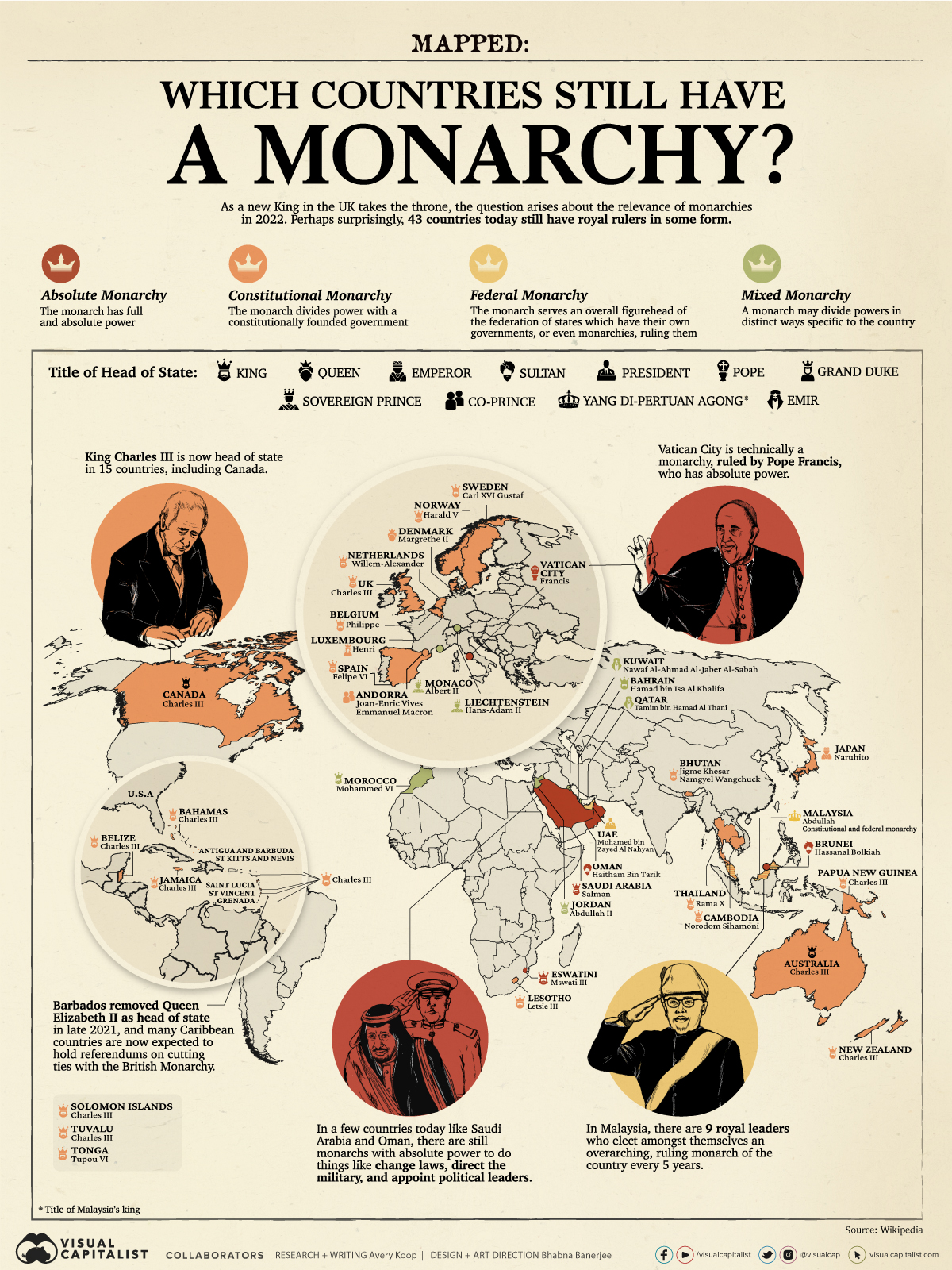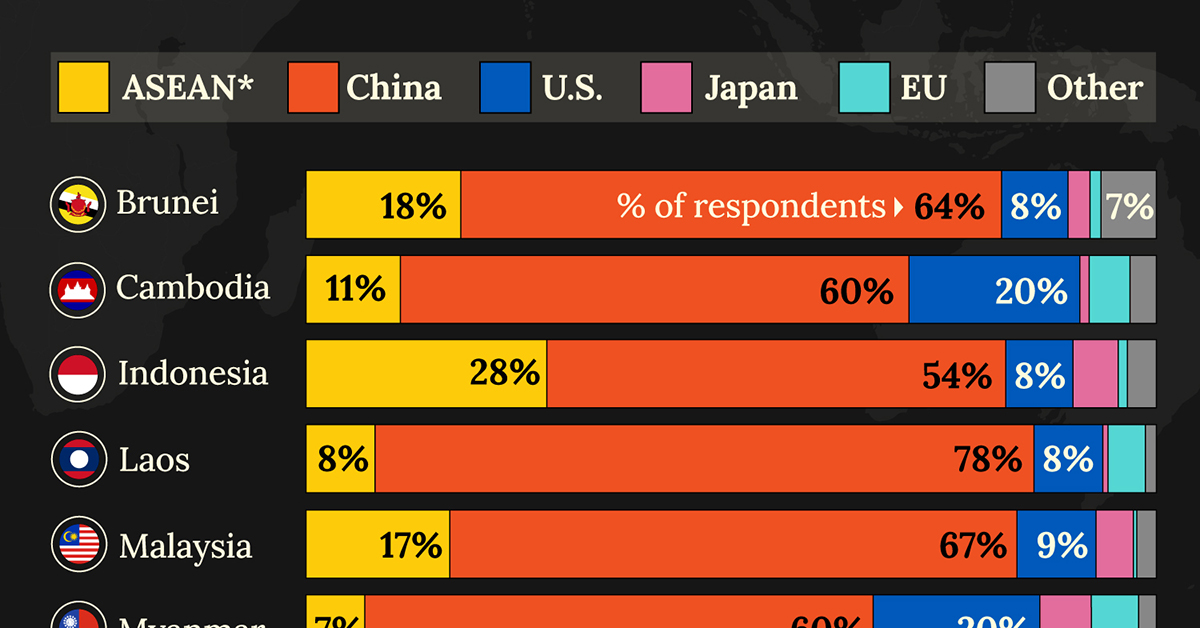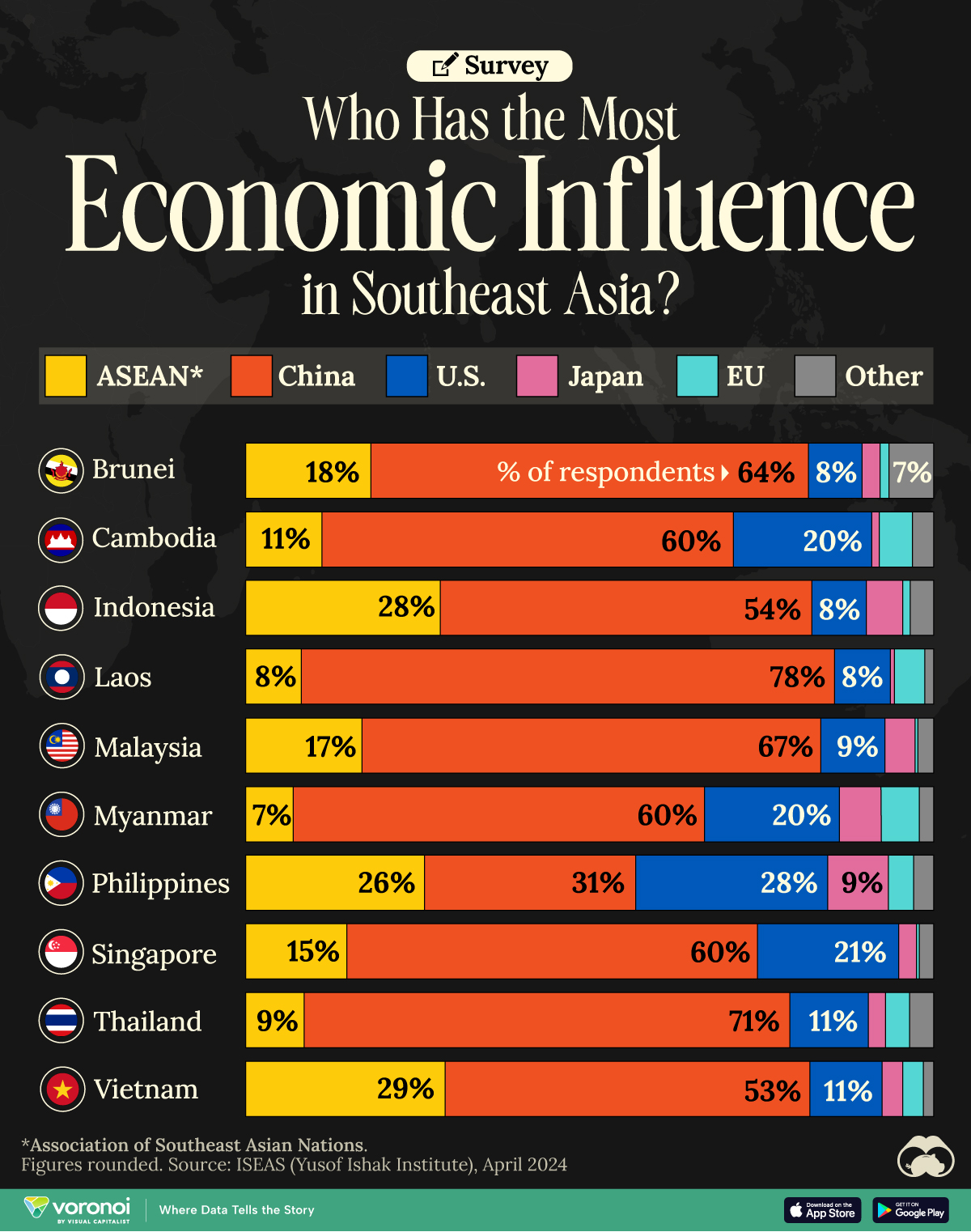Politics
Mapped: Which Countries Still Have a Monarchy?

Mapped: Which Countries Still Have a Monarchy?
In the wake of Queen Elizabeth II’s death, the question of monarchy is brought sharply into focus.
However, a surprising number of countries have ruling monarchs, and in this visual we break down the kinds of royal leadership across the 43 countries that still have them.
Types of Monarchies
A monarch in the simplest sense is a country’s king, queen, emir, or sultan, and so on. But before diving in, it’s important to break down the distinctions between the types of monarchies that exist today. Generally, there are four kinds:
① Constitutional Monarchy
The monarch divides power with a constitutionally founded government. In this situation, the monarch, while having ceremonial duties and certain responsibilities, does not have any political power. For example, the UK’s monarch must sign all laws to make them official, but has no power to change or reject new laws.
Here are some examples of countries with constitutional monarchies:
🇯🇵 Japan
🇬🇧 United Kingdom
🇩🇰 Denmark
② Absolute Monarchy
The monarch has full and absolute political power. They can amend, reject, or create laws, represent the country’s interests abroad, appoint political leaders, and so on.
Here are some examples of countries with absolute monarchies:
🇸🇿 Eswatini
🇸🇦 Saudi Arabia
🇻🇦 Vatican City
③ Federal Monarchy
The monarch serves an overall figurehead of the federation of states which have their own governments, or even monarchies, ruling them.
Here are some examples of countries with federal monarchies:
🇦🇪 UAE
🇲🇾 Malaysia
Malaysia is a unique form of federal monarchy. Every five years, each state’s royal leaders choose amongst themselves who will be the monarch, or the Yang di-Pertuan Agong, of Malaysia and the respective states. Furthermore, the monarchy is also constitutional, allowing a democratically elected body to govern.
④ Mixed Monarchy
This is a situation wherein an absolute monarch may divide powers in distinct ways specific to the country.
Here are some examples of countries with mixed monarchies:
🇯🇴 Jordan
🇱🇮 Liechtenstein
🇲🇦 Morocco
Interestingly, Liechtenstein is the only European monarchy that still practises strict agnatic primogeniture. Under agnatic primogeniture, the degree of kinship is determined by tracing descent from the nearest common ancestor through male ancestors.
Kings, Queens, Emperors, and Sultans Around the Globe
Now let’s break down the different monarchies country by country:
| Country | Type of Monarchy | Title of Head of State | Monarch | Title of Head of Government |
|---|---|---|---|---|
| 🇦🇩 Andorra | Constitutional | Co-Princes | Joan-Enric Vives, Emmanuel Macron | Prime Minister |
| 🇦🇬 Antigua and Barbuda | Constitutional | King | Charles III | Prime Minister |
| 🇦🇺 Australia | Constitutional | King | Charles III | Prime Minister |
| 🇧🇭 Bahrain | Mixed | King | Hamad bin Isa Al Khalifa | Prime Minister |
| 🇧🇪 Belgium | Constitutional | King | Philippe | Prime Minister |
| 🇧🇿 Belize | Constitutional | King | Charles III | Prime Minister |
| 🇧🇹 Bhutan | Constitutional | King | Jigme Khesar Namgyel Wangchuck | Prime Minister |
| 🇧🇳 Brunei Darussalam | Absolute | Sultan | Hassanal Bolkiah | Sultan |
| 🇰🇭 Cambodia | Constitutional | King | Norodom Sihamoni | Prime Minister |
| 🇨🇦 Canada | Constitutional | King | Charles III | Prime Minister |
| 🇩🇰 Denmark | Constitutional | Queen | Margrethe II | Prime Minister |
| 🇸🇿 Eswatini | Absolute | King | Mswati III | Prime Minister |
| 🇬🇩 Grenada | Constitutional | King | Charles III | Prime Minister |
| 🇯🇲 Jamaica | Constitutional | King | Charles III | Prime Minister |
| 🇯🇵 Japan | Constitutional | Emperor | Naruhito | Prime Minister |
| 🇯🇴 Jordan | Mixed | King | Abdullah II | Prime Minister |
| 🇰🇼 Kuwait | Mixed | Emir | Nawaf Al-Ahmad Al-Jaber Al-Sabah | Prime Minister |
| 🇱🇸 Lesotho | Constitutional | King | Letsie III | Prime Minister |
| 🇱🇮 Liechtenstein | Mixed | Sovereign Prince | Hans-Adam II | Prime Minister |
| 🇱🇺 Luxembourg | Constitutional | Grand Duke | Henri | Prime Minister |
| 🇲🇾 Malaysia | Constitutional & Federal | Yang di-Pertuan Agong | Abdullah | Prime Minister |
| 🇲🇨 Monaco | Mixed | Sovereign Prince | Albert II | Minister of State |
| 🇲🇦 Morocco | Mixed | King | Mohammed VI | Prime Minister |
| 🇳🇱 Netherlands | Constitutional | King | Willem-Alexander | Prime Minister |
| 🇳🇿 New Zealand | Constitutional | King | Charles III | Prime Minister |
| 🇳🇴 Norway | Constitutional | King | Harald V | Prime Minister |
| 🇴🇲 Oman | Absolute | Sultan | Haitham bin Tarik | Sultan |
| 🇵🇬 Papua New Guinea | Constitutional | King | Charles III | Prime Minister |
| 🇶🇦 Qatar | Mixed | Emir | Tamim bin Hamad Al Thani | Prime Minister |
| 🇰🇳 Saint Kitts and Nevis | Constitutional | King | Charles III | Prime Minister |
| 🇱🇨 Saint Lucia | Constitutional | King | Charles III | Prime Minister |
| 🇻🇨 Saint Vincent and the Grenadines | Constitutional | King | Charles III | Prime Minister |
| 🇸🇦 Saudi Arabia | Absolute | King | Salman | Prime Minister |
| 🇸🇧 Solomon Islands | Constitutional | King | Charles III | Prime Minister |
| 🇪🇸 Spain | Constitutional | King | Felipe VI | President of the Government |
| 🇸🇪 Sweden | Constitutional | King | Carl XVI Gustaf | Prime Minister |
| 🇹🇭 Thailand | Constitutional | King | Rama X | Prime Minister |
| 🇧🇸 The Bahamas | Constitutional | King | Charles III | Prime Minister |
| 🇹🇴 Tonga | Constitutional | King | Tupou VI | Prime Minister |
| 🇹🇻 Tuvalu | Constitutional | King | Charles III | Prime Minister |
| 🇦🇪 UAE | Federal | President | Mohamed bin Zayed Al Nahyan | Prime Minister |
| 🇬🇧 UK | Constitutional | King | Charles III | Prime Minister |
| 🇻🇦 Vatican City | Absolute | Pope | Francis | President of the Pontifical Commission |
Constitutional monarchies are undoubtedly the most popular form of royal leadership in the modern era, making up close to 70% of all monarchies. This situation allows for democratically elected governments to rule the country, while the monarch performs ceremonial duties.
Most monarchs are hereditary, inheriting their position by luck of their birth, but interestingly, French president, Emmanuel Macron, technically serves as a Co-Prince of Andorra.
Another unique case is the Vatican’s Pope Francis, who has absolute power in the small independent city—he gained his role thanks to an election process known as a papal conclave.
The Role of Monarchies
One of the most notable and famous ruling monarchies is the United Kingdom’s House of Windsor—also known as Queen Elizabeth II’s family. King Charles III has now ascended to the country’s throne, making him head of state in 15 nations total, including Canada, Australia, and New Zealand.
Many see the benefit in having a stable and consistent form of tradition and decorum at the country’s head of state.
“The Crown is an integral part of the institution of Parliament. The Queen [now King] plays a constitutional role in opening and dissolving Parliament and approving Bills before they become law.” – British Parliament
Japan’s royal family has been a prime example of stability, having reigned in the country for more than 2,600 years under the same hereditary line.
Critiques and the Future of Monarchy
Some claim, however, that there is no function of monarchy in the modern day, and complaints of monarchies’ immense wealth and power are rampant.
For example, according to the Dutch government, King Willem-Alexander’s budget for 2022, funded by the state and thus, taxpayers, comes out to more than €48 million.
Beyond tax dollars, with absolute monarchies there is typically a lack of political freedoms and certain rights. Saudi Arabia, for example, has no national elections. Rather its king, Salman bin Abdulaziz Al Saud, stays in power for life, appoints the cabinet himself, and passes laws by royal decree.
The death of Queen Elizabeth, though, may bring about change though for many of the world’s royally-governed. Since Barbados’ removal of her as head of state in 2021, six other Caribbean nations have expressed the desire to do the same, namely:
🇧🇿 Belize
🇧🇸 The Bahamas
🇯🇲 Jamaica
🇬🇩 Grenada
🇦🇬 Antigua and Barbuda
🇰🇳 St. Kitts and Nevis
The future of monarchy in the 21st century is certainly not a guarantee.
China
Which Countries Have the Most Economic Influence in Southeast Asia?
One country dominates this survey of who has the most economic influence in the region.

Countries With the Most Economic Influence in Southeast Asia
This was originally posted on our Voronoi app. Download the app for free on iOS or Android and discover incredible data-driven charts from a variety of trusted sources.
This chart visualizes the results of a 2024 survey conducted by the ASEAN Studies Centre at the ISEAS-Yusof Ishak Institute.
Nearly 2,000 respondents from 10 countries were asked to select which country/region they believe has the most influential economic power in Southeast Asia.
The countries surveyed are all member states of the Association of Southeast Asian Nations (ASEAN), a political and economic union of 10 countries in Southeast Asia.
Southeast Asia Perceptions: Who’s Got Economic Influence?
Across all ASEAN nations, China is regarded as the region’s most influential economic power.
Laos and Thailand had the highest share of respondents picking China, at 78% and 71% respectively. As the report points out, China is Laos’ largest foreign investor as well as its top export market.
| Country | 🇨🇳 China | 🌏 ASEAN | 🇺🇸 U.S. |
|---|---|---|---|
| 🇧🇳 Brunei | 64% | 18% | 8% |
| 🇰🇭 Cambodia | 60% | 11% | 20% |
| 🇮🇩 Indonesia | 54% | 28% | 8% |
| 🇱🇦 Laos | 78% | 8% | 8% |
| 🇲🇾 Malaysia | 67% | 17% | 9% |
| 🇲🇲 Myanmar | 60% | 7% | 20% |
| 🇵🇭 Philippines | 31% | 26% | 28% |
| 🇸🇬 Singapore | 60% | 15% | 21% |
| 🇹🇭 Thailand | 71% | 9% | 11% |
| 🇻🇳 Vietnam | 53% | 29% | 11% |
Note: Percentages are rounded.
Other ASEAN countries usually score highly as well, along with the United States.
It’s only in the Philippines, where China (31%), the U.S. (28%) and ASEAN (26%) were perceived as having a similar amount of influence.
ASEAN, Japan, and the EU
Filipinos also rated Japan’s economic influence the highest (9%) compared to those surveyed in other ASEAN countries. In 2023, the Southeast Asian bloc celebrated 50 years of friendship with Japan, marking it as one of their most important “dialogue partners.”
| Country | 🇯🇵 Japan | 🇪🇺 EU | 🌐 Other |
|---|---|---|---|
| 🇧🇳 Brunei | 3% | 1% | 7% |
| 🇰🇭 Cambodia | 1% | 5% | 3% |
| 🇮🇩 Indonesia | 5% | 1% | 3% |
| 🇱🇦 Laos | 1% | 4% | 1% |
| 🇲🇾 Malaysia | 4% | 0% | 2% |
| 🇲🇲 Myanmar | 6% | 6% | 2% |
| 🇵🇭 Philippines | 9% | 4% | 3% |
| 🇸🇬 Singapore | 3% | 0% | 2% |
| 🇹🇭 Thailand | 3% | 4% | 4% |
| 🇻🇳 Vietnam | 3% | 3% | 2% |
Note: Percentages are rounded. Other countries include: Australia, South Korea, India, and the UK.
The EU also received single-percentage responses, its highest share coming from Myanmar (6%), Cambodia (5%), and Laos (4%).
Finally, the report contrasted China’s robust economic influence with concerns about its growing impact in the region. Respondents from Vietnam (88%), Myanmar (88%), and Thailand (80%) had the highest levels of concern, despite their countries’ strong trade ties with China.
-

 Personal Finance1 week ago
Personal Finance1 week agoVisualizing the Tax Burden of Every U.S. State
-

 Misc6 days ago
Misc6 days agoVisualized: Aircraft Carriers by Country
-

 Culture6 days ago
Culture6 days agoHow Popular Snack Brand Logos Have Changed
-

 Mining1 week ago
Mining1 week agoVisualizing Copper Production by Country in 2023
-

 Misc1 week ago
Misc1 week agoCharted: How Americans Feel About Federal Government Agencies
-

 Healthcare1 week ago
Healthcare1 week agoWhich Countries Have the Highest Infant Mortality Rates?
-

 Demographics1 week ago
Demographics1 week agoMapped: U.S. Immigrants by Region
-

 Maps1 week ago
Maps1 week agoMapped: Southeast Asia’s GDP Per Capita, by Country






